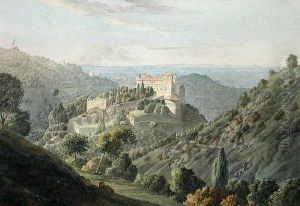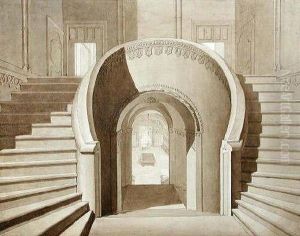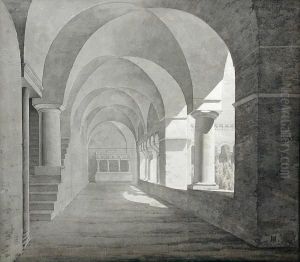Gustav Friedrich Hetsch Paintings
Gustav Friedrich Hetsch was a German architect and designer, born on September 28, 1788, in Stuttgart, Germany. His work is often associated with the neoclassical movement, a style that sought to revive the principles and aesthetics of ancient Greek and Roman architecture. Hetsch's education and career were marked by significant periods of study and practice in various parts of Europe, which greatly influenced his architectural philosophy and style.
After completing his initial studies in Germany, Hetsch moved to Paris to further his education. In Paris, he became a student at the École des Beaux-Arts, one of the most prestigious art and architecture schools in the world. During his time in Paris, he worked under the tutelage of Charles Percier and Pierre François Léonard Fontaine, two architects who were instrumental in the development of the Empire style in France. This period was crucial in shaping Hetsch's approach to architecture, imbuing him with a deep appreciation for classical proportions and detailing.
In 1815, Hetsch relocated to Denmark, where he would leave a lasting impact on Danish architecture. He was appointed professor at the Royal Danish Academy of Fine Arts in Copenhagen and later became the academy's director. His work in Denmark includes significant public and private buildings, such as the design for the Church of Our Lady in Copenhagen, which is considered one of his masterpieces. The church showcases Hetsch's skill in blending neoclassical elements with a sense of monumental grandeur, creating a space that is both reverent and aesthetically compelling.
Throughout his career, Gustav Friedrich Hetsch was not only concerned with the aesthetics of buildings but also with the functional and social aspects of architecture. He believed that architecture should serve the needs of society and contribute to the well-being of its inhabitants. This philosophy was reflected in his emphasis on clear, rational layouts and his consideration for light and space within his designs.
Gustav Friedrich Hetsch passed away on September 17, 1864, in Copenhagen. His contributions to architecture, particularly in Denmark, have been recognized for their elegance, clarity, and adherence to classical principles. Hetsch's legacy is evident in the continued appreciation and study of his works, both in Denmark and internationally. His influence extends beyond his buildings, as he played a significant role in shaping the architectural education of his time, leaving a lasting imprint on generations of architects.


